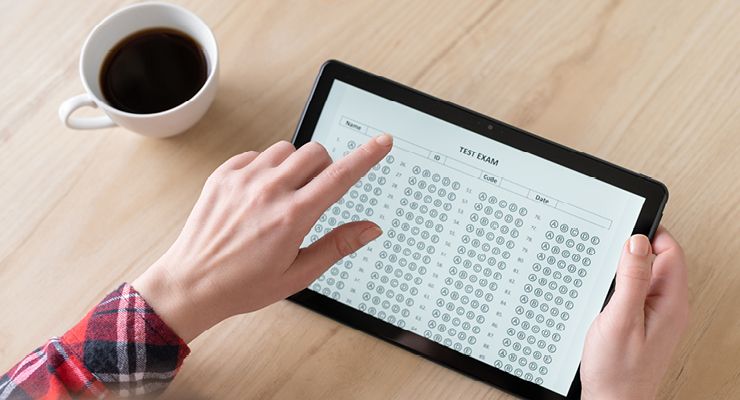 Written by: Jen Carlevatti // Dec 15, 2020
Written by: Jen Carlevatti // Dec 15, 2020
Last updated: Jan 17, 2023
This year, in response to the COVID-19 pandemic, many college admissions offices are waiving the need for standardized test scores. However, plenty of schools still require an official score report before they will review your application for undergraduate or graduate admission (USF is one of them). Online exams can be a safe way to fulfill this requirement. If you’re not familiar with this option, here’s what you need to know about online standardized testing.
Are All Standardized Tests Available Online?
Almost all standardized tests are available in an online version. Some tests can be taken in the comfort of your home, while others require your presence at a designated testing center. Here is where the five most common tests stand.
SAT
College Board has been slow to embrace the move toward online testing. Currently, the most widely available test method is paper based, but some students can take the test on a computer when it’s administered by a school. The content of both test types is the same. At the beginning of the pandemic, the College Board began planning for an online test administered at home, but it has since scrapped the idea amid test security concerns.
ACT
You can choose how you want to take the ACT — online or on paper — but you must take it at a test center or at school. The only difference between the online ACT and paper ACT is how they are administered. Both exams have the same content, timing, question types, structure, and scoring. Like the SAT, plans for an at-home version of the online ACT test are on hold.
LSAT
In May 2020, the Law School Admissions Council began offering an online, remotely proctored version of the LSAT called the LSAT-Flex. This three-section test uses the same question types as the traditional LSAT (analytical reasoning, logical reasoning, and reading comprehension) and can be taken at home.
GRE
If you’re unable to take the GRE General Test at a test center, it can be taken on your own computer at home and monitored by an online proctor. The online test is identical in content, format, and on-screen experience to a test taken at a test center, and it is available 24 hours a day, seven days a week.
GMAT
An online and remotely proctored GMAT has been implemented on an interim basis. The online test is a bit different than the one you’ll encounter at a test center. It’s roughly 20 minutes shorter, contains three sections instead of four, and only one re-test is permitted.

Differences Between Paper-Based and Online Tests
Yes, one test is on paper and the other is on a computer, but there are some other not-so-obvious differences you should know about.
Enhanced Security
If you’re taking the test at home, you’ll complete a security check-in with the proctor. This could involve showing your ID and holding up various items in your workspace to ensure they comply with the rules. Throughout the test, you will be monitored by the proctor using your computer’s camera and microphone, and the video/audio likely will be recorded in case a review is necessary.
Electronic Test-Taking Tools
There are some nifty tools available to online test takers. Features vary by test, but some of the more common ones allow you to:
- Bookmark items to return to later.
- Keep track of time left in a section with a countdown clock.
- Cross off answers you want to eliminate.
- Mark unanswered questions.
- Use electronic scratch paper.
- Highlight passages.
- Use electronic whiteboards.
Adaptive Questioning
Some online tests, including the GMAT and GRE, are adaptive. These tests adjust the level of questioning according to how the test taker performs on prior questions. Low scorers are asked fewer of the hardest questions, and high scorers aren’t asked as many of the easy questions. It can provide a more detailed picture of what you have mastered.
Technology Challenges
You may be wondering what happens if your internet connection drops out, your computer crashes, or another tech challenge presents itself in the middle of the test. Fear not.
Test administrators use a number of strategies to ensure you don’t have to start over. Some use propriety software with built-in redundancies (for example, your answers may be saved on multiple servers). Others use local servers at the testing center to deliver the test to your computer, collect the answers, and upload them to the test administrator.
Once you get back online, you may need to complete the security check-in again before returning to your test, but you will not need to start over or re-take the test on another day.
How to Prepare for an Online Test
Once you’ve made the decision to take an online test, the steps to prepare for it are similar to a paper-based test.
First, consider making an investment in an online test prep course. It’s a great way to review key concepts, discover strategies for tackling different question types, learn how to manage time, and take practice exams in a structured environment. Test prep apps are another convenient way to supplement a formal online test prep course.
If you forgo a paid test prep course, it’s essential to take online practice tests. They’re typically offered for free by your test’s administrator and can help you pinpoint any problem areas, such as content you haven’t mastered yet or whether anxiety/fatigue are at play.
Practice tests can also help you get comfortable with the online testing format and tools. Be sure to simulate actual test conditions for the best results. Turn off your phone, eliminate interruptions, have a set start/end time, keep strict timing for each section, and only take breaks that will be permitted on test day.
The day before your test, gather your ID and any permitted materials, such as scratch paper or calculators, so you don’t have to rush. Make sure you know the specific rules for your test (for example, beverages may only be allowed in clear containers). If you’re taking the test at home, check your computer equipment, download any necessary apps, and ensure you’re located in a spot with a strong Wi-Fi connection.
With adequate prep, you’ll be in an excellent position to perform well on the online test and gain admission to your school of choice.

Need a Good Test Prep Program? USF Can Help With That.
Whether you’re getting ready for the SAT, ACT, GRE, GMAT, or LSAT, USF’s live online test prep courses can equip you with the knowledge and skills to earn your best score. No trips to campus required. Explore our upcoming courses, and if you have questions, reach out to us at 813-974-0950 or CE-Inquiries@usf.edu.


